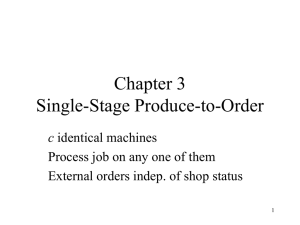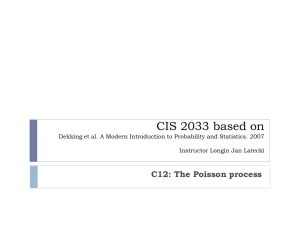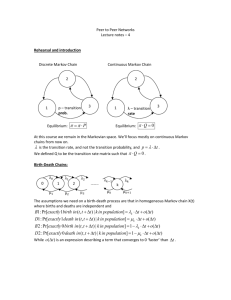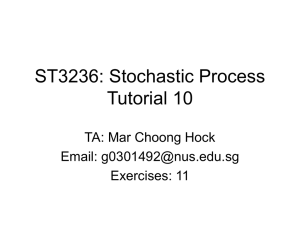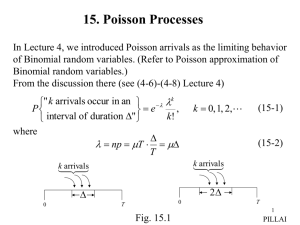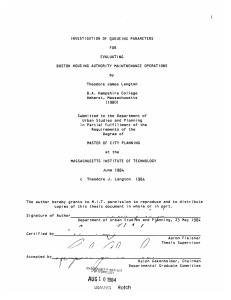CS 547 Lecture 10: The Poisson Process
advertisement
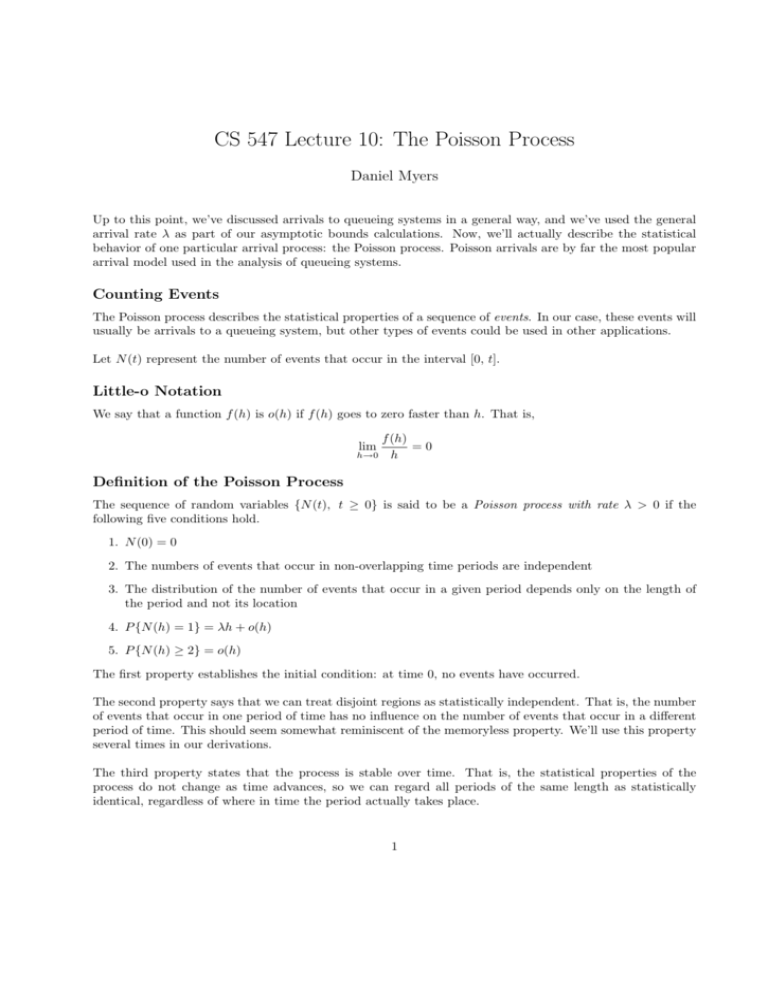
CS 547 Lecture 10: The Poisson Process
Daniel Myers
Up to this point, we’ve discussed arrivals to queueing systems in a general way, and we’ve used the general
arrival rate λ as part of our asymptotic bounds calculations. Now, we’ll actually describe the statistical
behavior of one particular arrival process: the Poisson process. Poisson arrivals are by far the most popular
arrival model used in the analysis of queueing systems.
Counting Events
The Poisson process describes the statistical properties of a sequence of events. In our case, these events will
usually be arrivals to a queueing system, but other types of events could be used in other applications.
Let N (t) represent the number of events that occur in the interval [0, t].
Little-o Notation
We say that a function f (h) is o(h) if f (h) goes to zero faster than h. That is,
f (h)
=0
h→0 h
lim
Definition of the Poisson Process
The sequence of random variables {N (t), t ≥ 0} is said to be a Poisson process with rate λ > 0 if the
following five conditions hold.
1. N (0) = 0
2. The numbers of events that occur in non-overlapping time periods are independent
3. The distribution of the number of events that occur in a given period depends only on the length of
the period and not its location
4. P {N (h) = 1} = λh + o(h)
5. P {N (h) ≥ 2} = o(h)
The first property establishes the initial condition: at time 0, no events have occurred.
The second property says that we can treat disjoint regions as statistically independent. That is, the number
of events that occur in one period of time has no influence on the number of events that occur in a different
period of time. This should seem somewhat reminiscent of the memoryless property. We’ll use this property
several times in our derivations.
The third property states that the process is stable over time. That is, the statistical properties of the
process do not change as time advances, so we can regard all periods of the same length as statistically
identical, regardless of where in time the period actually takes place.
1
The fourth and fifth properties tell us about the behavior of the process in very small windows of time. The
fourth property says that the probability of getting one event in a small window of time is proportional to
the length of the window, plus some error term that goes to zero as the window size shrinks to zero. The
fifth property says that the probability of getting two or more events in a window of time goes to zero as
the window becomes very small.
Using the fourth and fifth properties, we can derive a simple proposition.
P {N (h) = 0} = 1 − P {N (h) ≥ 1}
= 1 − λh − o(h)
Key Properties of the Poisson Process
Using the defintion of the Poisson process, we can now derive three key results that summarize its behavior.
• The number of events in a period is Poisson
• Events in the process occur at constant rate λ
• The time between events is exponentially distributed with parameter λ
The Distribution of the Number of Events
In this section, we’ll show that the number of events generated by the Poisson process over a period of length
t follows a Poisson distribution.
First, we’ll derive an expression for P {N (t) = 0}, then state the general distribution.
Consider P {N (t + h) = 0}. If we get no events in [0, t + h], then we received no events in [0, t] and no events
in [t, t + h]. Therefore,
P {N (t + h) = 0} = P {N (t) = 0 and N (t + h) − N (t) = 0}
The two periods are non-overlapping, so we can treat them independently (using the second part of the
definition), and write the joint probability as the product of the individual probabilities.
P {N (t + h) = 0} = P {N (t) = 0} P {N (t + h) − N (t) = 0}
The second term is simply a period of length h, which is statistically identical all other periods of length h
by the third part of the definition of the Poisson process.
P {N (t + h) = 0} = P {N (t) = 0} P {N (h) = 0}
= P {N (t) = 0}(1 − λh − o(h))
To simplify notation, let P0 (t) = {N (t) = 0}. We now have
P0 (t + h) = P0 (t)(1 − λh − o(h))
Rearranging and dividing both sides by h,
P0 (t + h) − P0 (t)
o(h)
= −λP0 (t) −
P0 (t)
h
h
Now, take the limit of both sides as h → 0.
lim
h→0
P0 (t + h) − P0 (t)
o(h)
= lim −λP0 (t) −
P0 (t)
h→0
h
h
2
The o(h) term goes to zero. The left hand side is simply the definition of the derivative of P0 (t), so we obtain
a differential equation.
∂
P0 (t) = −λP0 (t)
∂t
Solving the equation yields
P0 (t) = P {N (t) = 0} = e−λt
This result can be extended to show that the probability of getting k events during a period of length t
follows a Poisson distribution with parameter λ.
P {N (t) = k} =
e−λt (λt)k
k!
Setting k = 0 gives e−λt , as expected.
The expected number of events in a period is simply
E[N (t)] = λt
Events Occur At Constant Rate
By definition, the rate of arrivals is the expected number of arrivals in a period, divided by the length of the
period.
expected number of arrivals
rate of arrivals =
length of period
For the Poisson process, the rate of arrivals over a period of length t is
rate of arrivals over t =
λt
=λ
t
The expected rate of arrivals over any period is simply λ, regardless of the length of the period.
By extension, the expected time between arrivals is
1
λ.
Note: a constant arrival rate is not the same as a constant interarrival time!
The Time Between Events is Exponentially Distributed
Let T1 be the time until the first event, and T2 be the time between the first and second events. We would
like to derive the distribution of T2 , and by extension, the distribution of the time between any two events.
Suppose the first event occurs at time t. We’ll reason about the CCDF of T2 conditioned on T1 = t.
P {T2 > s | T1 = t}
T2 is the time between the first and second events, so if T2 > s, no events can occur in the time between t
and t + s.
P {T2 > s | T1 = t} = P {no events in [t, t + s] | T1 = t}
The time periods [0, t] and [t, t + s] are non-overlapping, so we can treat them independently. Therefore, we
can remove the conditioning on T1 .
P {T2 > s | T1 = t} = P {no events in [t, t + s]}
3
Further, the period from t to t + s is simply a period of length s, so we can treat it the same as any other
period of length s.
P {T2 > s | T1 = t} = P {no events in a period of length s}
= P {N (s) = 0}
= e−λs
The final step is simply our previous result for the probability of getting 0 events during a period.
Therefore, T2 has the CCDF of an exponential distribution with parameter λ.
4

